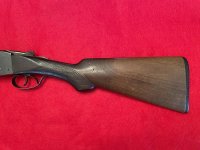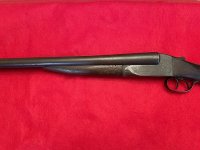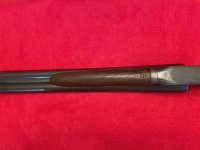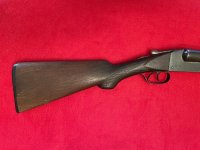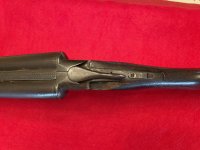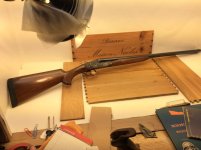The Flues Models are a decent SxS.
They do have a couple of weaknesses that are fairly common.
The broken upper stock 'ears' right along the top tang and up against the frame is one.
That's a design fault of the stock to frame attachment.
The Flues does not have what most any other SxS has inside and that is an angled interface betw the stock and the frame. The angled piece on the frame is usually on the trigger plate but being a solid piece when bolted up to the frame, it can be considered as one.
What that does as the Top Tang Screw is tightened is to pull the Frame and the Stock together. It tightens the assembly of the two components.
In the Flues,,there is not such interface.
The large Top Tang Screw which is just under the Top Lever is just a very short coarse threaded Wood Screw.
It has little holding power as the depth of the thread is short and in these older guns many are simply stripped in the wood and hold little if nothing.
The only thing holding the Frame back solidly into the stock inlet is the Rear Tang Screw which inserts from the bottom.
It in itself is a very small dia screw for the job and again has no interlocking effect.
What happens is that the Frame becomes loose in it's stock inlet over time.
That allows the frame to rotate up and back when the gun is fired. It's a very small amt but with it the top rear edge of the frame pushes against the wood there and the stock 'Ears' crack and break.
The stock at the wrist on tap just behind the top tang also is common to have cracked.
There are ways to reinforce the Flues. Glass Bedding is one. That Top Tang Screw is sometimes replaced with a machine thread screw and a threaded nut is imbedded into the wood of the stock in glass bedding for it to thread in to.
If a bit of 'Draw' is carefully planned out in the placement of the screw and nut so when inserted and tightened, it can have the same effect as the sloped interface in other stock designs. Just not as much but it helps.
The Rear Tang screw can also be 'loaded' so when tightened it draws the frame to the rear and tightly into the wood inlet.
The Flues frame is a very thin shell of a design.
The sides are very thin and there are the coil mainspring voids drilled near horizonally just under the surface on both sides that further weaken it.
It's a not so uncommon trait for the Flues frame to crack vertically from the intersection of the standing breech straight down the sides to the bottom of the recv'r.
This is seen more on the extreme lightweight small biore guns that were trimmed down even further in attempts to make an under 6# SxS.
But the standard frames in 12 and other gauges are effected too.
The somewhat sharp corner where the standing breech and action flat meet is not the best engineering design and probably doesn't help matters. But it's there.
The Breech Shields, the rounded Mickey Mouse ears on the frame that sit behind the bbl chambers are generally filed very thin also.
All this to save weight.
It makes for a somewhat fragile frame design but it was 1905 or so when it was designed and BP was still king with most smokless-nitro loads being Bulk Smokless Powder that was loaded vol/vol the same as BP.
Many of the Flues will be stamped 'Nitro Proved' on the bottom of the bbl lug. Take the bbls off and turn them upside down . It's generally on the very tip of the bbl lug betw the breech.
Ithaca offered the Flues with both Steel and Damascus bbl's during production or at least the first 10yrs or so.
People sometimes trusted Damascus/Twist/Laminated steel bbls at the time more than those new Fluid Steel bbls being sold.
Old habits.
Winchester was doing the same with offering both for the Model 97.
Are the Damascus bbls safe to shoot? A question only you can decide. There is plenty of info out there to argue both sides of the issue.
I shoot them at times still. I used to shoot them a lot more and always with my own low pressure Smokeless handloads. IMR 7625 was my fav powder. Disc now but I have a good supply.
Nitro at the time was not 21st century smokeless loads.
I would not shoot OTC 12ga loads out of a Flues. Plenty have and the guns hold together.
But they just were not made for that.
BP chamber pressure in a 12ga is generally accepted at 6500 to 7000 psi
Bulk Smokeless of the time was designed to mimic BP pressures and use in reloading (Vol per Vol).
Todays OTC 12ga rounds are generally loaded to max SAAMI pressures by the mfg'rs to make sure customers are happy that their Benelli's all work fine. SAAMI Max service pressure for 12ga is 11,500 psi.
Chamber length in a Flues in 12ga was 2 5/8.
If you carefully measure one with a chamber casting so you can really see where the chamber ends and the forcing cone begins you will usually get a measurement closer to 2 1/2"
Not uncommon to see this in that era.
Remington, Parker and others would cut their shotgun chamber lenghts just short of what the standard or stated length was.
This is noted in old factory specs and correspondence.
The Forcing Cone ahead of the chamber in these oldies is very short and very abrupt. A very steep angle for the wads and shot charge to be funneled from hull into the bore.
All designed including the slightly short chambers, so as to make the most in velocity and patterning results with the shells loaded at the time.
Those being Paper hulls, Hard Cardboard over powder wads and cushioning wads of various material such as fiber, cork and even leather.
We don't (usually) load that anymore.
So now the slick plastic shell and one piece wad is there,
So it unfolds partially in that short steep angled forcing cone.
every gun is different. Every factory cut theirs differently.
You just can't say that any shell longer than the real chamber length is going to be safe in any short chamber / forcing cone spec in any shotgun .
Way too many variables.
People freak out when shotshell loaders wander off the reloading guide printed recipe and start substituting components.
A change in Primer it is often said can (not always) boost chamber pressure 2000psi.
I don't know if that's true of not but anyone that reloads will tell you that when switching components to start the load over again an Min.
Problem is that there are no Min/Max loads in the shotshell reloading charts.
That one gun with short chamber(s) has successfully stood up to a constant diet of 'long' shells is not guarantee about anything.
They are all different and the materials , heat treat, finishing, fitting ect that went into the making of say a Win 12 of the same ear are so different that that Flues Ithaca.
Take them apart like I have and repair them like I have for the last 50yrs and you'll see why the Flues while a perfectly good shotgun for general use is in no way a strong action.
I've fixed a lot of Flues models over the years and they are not an engineering marvel. Very weak design in several ways if I had to make one statement.
But if in good mechanical condition and used as they were intended they will last a good long time.

